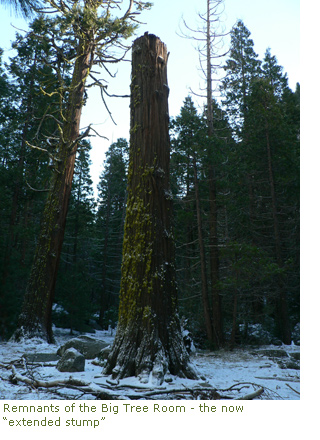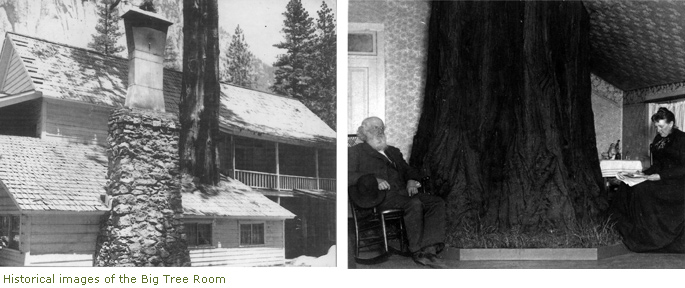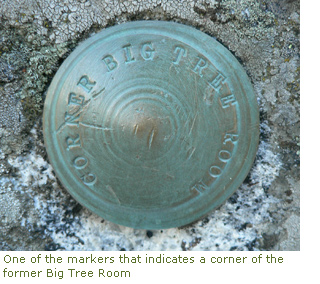 As you venture into Yosemite Valley, your journey will undoubtedly involve a trip down Southside Drive. You cruise along with the bustle of traffic, passengers shuffling through maps and kids hollering in the backseat. You pass a beautiful little chapel while pulling up to a stop sign, and glance to your right for just a moment. That's where you will catch a glimpse of a broad opening in the forest with a single tree in the middle. This tree, however, is very peculiar indeed. It seems conflicted, as if it can't make up its mind between being a tree or a stump. This "extended stump" of sorts stands about twenty-five feet high and is covered with an uneven coat of neon green wolf lichen, making it stand out even further from the surrounding vegetation. Why does it stand in this clearing? What changes has this tree witnessed during its life in the Valley? This branchless sentinel surely has a story to tell.
As you venture into Yosemite Valley, your journey will undoubtedly involve a trip down Southside Drive. You cruise along with the bustle of traffic, passengers shuffling through maps and kids hollering in the backseat. You pass a beautiful little chapel while pulling up to a stop sign, and glance to your right for just a moment. That's where you will catch a glimpse of a broad opening in the forest with a single tree in the middle. This tree, however, is very peculiar indeed. It seems conflicted, as if it can't make up its mind between being a tree or a stump. This "extended stump" of sorts stands about twenty-five feet high and is covered with an uneven coat of neon green wolf lichen, making it stand out even further from the surrounding vegetation. Why does it stand in this clearing? What changes has this tree witnessed during its life in the Valley? This branchless sentinel surely has a story to tell. Best estimates would say that this tree sprouted in the early 1700s. It grew taller in the great grassy valley known as Ahwahnee, perhaps providing shade for the native people of this valley, the Ahwahneechee. It spread its branches in the presence of the grizzly bears that thrived here, and was over 100 years old when Euro-Americans first gazed upon Yosemite Valley from above. In 1833 the Walker party did not find their way down onto the Valley floor, but surely looked on with amazement from above and continued on their hunting trek through the Sierra Nevada. The tree would not meet Euro-Americans more intimately until 1851, when the Mariposa Battalion entered the Yosemite Valley to drive out the Ahwahneechee people. The tree watched people's movements in the Valley, yet unchanged. Their visit, however, started the rumor of this incredible place, and in 1855 the first tourists may have taken pause beneath its spreading boughs. At first, tourism growth was slow in the Valley, with no formal roads and difficult travel. Growth was inevitable, and in 1863 our incense cedar experienced a new and different kind of growth firsthand when a man by the name of Hutchings turned his attention to the majestic tree.
James Mason Hutchings was born in England and moved to the United States in 1848 at the age of 28. A young and ambitious man, he came west to California in the first years of the gold rush. He was one of the few to strike it rich, and later went on to make further fortunes as a publisher. Hutchings, however, was not the kind to be confined behind a desk. Hearing of the great grassy Valley with "thousand foot cliffs and waterfalls" he felt compelled to seek it out. Combining a true love of nature and adventure with his business acumen, he was responsible for bringing the first group of tourists to Yosemite in 1855. Working as both a guide and a publisher, he was able to bring this place into the limelight. His love for Yosemite grew with such vigor that in 1864, he purchased the Upper Hotel, a crudely built establishment that was hastily erected beside the majestic cedar. Hutchings knew that remodeling and expanding was necessary in order to provide better comfort to his visitors, but he couldn't bear to cut down the now fully grown tree. You could say that Hutchings then found a way "around" it with the creation of the new and improved Hutchings House.

The incense cedar, at the time over 100 years old, stood tall and proud still as it grew up directly through the center of the newly expanded hotel. The room in which it stood was aptly named the "Big Tree Room," and was undoubtedly a popular lounging area for visitors to this early Park. It is impossible to say how many people came to see it during the heyday of Hutchings House. John Muir himself, who worked in a sawmill for Hutchings during his formative years in Yosemite, may have rested a weary hand upon it at the end of a hard day's work. This tree then went on to watch the changes that preservation brought to the Valley, as Hutchings was bought out within a decade by the State of California (an arguable overly generous sum of $24,000 was paid for his claim) and the hotel slipped away into disrepair.
 Annual rings show that the incense cedar grew very slowly once the hotel was built around it. It survived on long after the hotel fell into disrepair, maintaining its health through the turn of two more centuries. The tree eventually died around 2002 or 2003. With the roadway so close by, Yosemite's head forester knew that the tree had to be removed before it caused major injury or accident. In 2004, work was done to take the tree down. At the end of its life, it was measured at 130 feet tall, and 72 inches across. The legacy of all that the incense cedar had seen is certainly not dead. Today four markers stand in that opening to show where the corners of the big tree room once stood. Gazing up on the extended stump left behind, one can even pick out the nail holes where the building had been mounted to it. The tree is still alive in a sense with the carpet of wolf lichen that make a living on the surface of its rotting bark. It also lives on in the hearts and minds of visitors who know its place in Yosemite's early story. Perhaps it even lives on in the smaller cedars that grow nearby, its progeny going on to serve as sentinels for the Valley once called Ahwahnee.
Annual rings show that the incense cedar grew very slowly once the hotel was built around it. It survived on long after the hotel fell into disrepair, maintaining its health through the turn of two more centuries. The tree eventually died around 2002 or 2003. With the roadway so close by, Yosemite's head forester knew that the tree had to be removed before it caused major injury or accident. In 2004, work was done to take the tree down. At the end of its life, it was measured at 130 feet tall, and 72 inches across. The legacy of all that the incense cedar had seen is certainly not dead. Today four markers stand in that opening to show where the corners of the big tree room once stood. Gazing up on the extended stump left behind, one can even pick out the nail holes where the building had been mounted to it. The tree is still alive in a sense with the carpet of wolf lichen that make a living on the surface of its rotting bark. It also lives on in the hearts and minds of visitors who know its place in Yosemite's early story. Perhaps it even lives on in the smaller cedars that grow nearby, its progeny going on to serve as sentinels for the Valley once called Ahwahnee. 